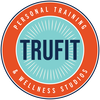|
Ah, the kettlebell swing: Such a POWERFUL exercise that's often misunderstood... and butchered. There are a few different styles of kettlebell swings (Russian, American, CrossFit to name a few) and, we think it's safe to say, some are safer and more effective than others. We've seen our fair share of butchered swings in our time which give swings a bad name! When done *properly*, though, kettlebell swings can do wonders for your strength gains and health! This is why today, Kathryn Lehner, Strong First kettlebell instructor and one of the awesome trainers who works out of TruFit Personal Training in Evanston, is going to give us some quick dos and don'ts when doing this booty-firming, heart-pounding, hard-style version of one of our favorite exercises: The kettlebell swing. Here is Kathryn's own story about why the swing is so freaking awesome:
1. Want to get your butt strong and look good doing it? Swing a kettlebell! Why you ask? Because it is a great way to get your butt strong! But getting a stronger rear is only one of many benefits to the kettlebell swing. In addition to your behind, the swing helps to strengthen your entire posterior chain and core. When done properly, the swing is a high-power, full-body explosive movement with weight. It involves activation of most back muscles, explosive strength, rhythm, and provides a high level of conditioning. Total. Body. Exercise. 2. The swing is a dynamic hip hinge. The body movement in deadlifts and swings -- when done properly -- is the best way to pick something up! It also happens to be the most efficient way to jump. The hip hinge is technically the strongest movement we can make as it encourages and ensures the center of the body is strong and stable. 3. Since we recognize that the kettlebell swing is a hinge movement, this means it is NOT a squat. There is a big difference between the hinge and the squat. In a squat the knees and hips move at the same speed and the same rate. At the bottom of the movement, one's hips and knees are about the same height. In a hip hinge, the butt goes back first, allowing the knees to bend naturally. At the bottom of the swing (and deadlift), the hips are above one's knees and below the shoulders. 4. While performing a swing, the kettlebell makes a pendulum type motion in a steady rhythm. If it doesn't, there is most likely energy leakage happening somewhere throughout the body. Check in with the video to make sure you're doing the dos and not doing the don'ts. :) This awesome movement strengthens your posterior chain, helps with fat loss, and aids in back health -- all good things! Want to know more? Come swing with us! To get in touch with Kathryn, email her here or give TruFit a call!
0 Comments
|
Archives
April 2024
Categories! |

 RSS Feed
RSS Feed